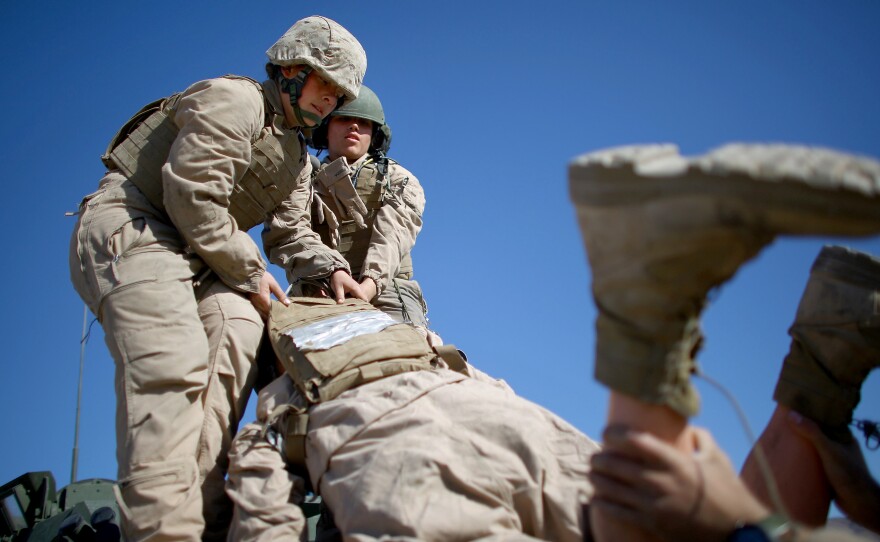A year-long Marine Corps study trying to understand how gender integration would affect combat readiness has found that all-male units were faster, more lethal and able to evacuate casualties in less time.
Overall, according to a summary of the study, all-male squads performed better than mixed groups in 69 percent of the tasks evaluated.
NPR's Tom Bowman filed this report for our Newscast unit:
"The Marines created a battalion of 100 female and 300 male volunteers. During the past year, they trained in North Carolina and California, taking part in realistic combat exercises.
"All-male squads, the study found, performed better than mixed gender units across the board. The males were more accurate hitting targets, faster at climbing over obstacles, better at avoiding injuries.
"The Marine study says its main focus is maximum combat effectiveness, because it means fewer casualties. The Marines have not said whether the study's results will lead them to ask for a waiver that bars women from ground combat jobs.
"Defense Secretary Ash Carter said he hopes to open all combat jobs to women."
From the summary of the study, here are some key findings:
Speed: All-male squads, regardless of infantry MOS, were faster than the gender-integrated squads in each tactical movement. The differences were more pronounced in infantry crew-served weapons specialties that carried the assault load plus the additional weight of crew-served weapons and ammunition.
Lethality: All-male 0311 (rifleman) infantry squads had better accuracy compared to gender-integrated squads. There was a notable difference between genders for every individual weapons system (i.e. M4, M27, and M203) within the 0311 squads, except for the probability of hit & near miss with the M4.
Injuries: In addition to performance, evidence of higher injury rates for females when compared to males performing the same tactical tasks was noted. The well documented comparative disadvantage in upper and lower-body strength resulted in higher fatigue levels of most women, which contributed to greater incidents of overuse injuries such as stress fractures. Research from various U.S. and allied military studies reveal that the two primary factors associated with success in the task of movement under load are 1) lean body mass and 2) absolute VO2 Max.
And here are some raw numbers that help explain the different physiologies:
• Body composition: Males averaged 178 lbs, with 20% body fat: females averaged 142 lbs, with 24% body fat
• Anaerobic Power: Females possessed 15% less power than males; the female top 25th percentile overlaps with the bottom 25th percentile for males
• Anaerobic Capacity: Females possessed 15% less capacity; the female top 10th percentile overlaps with the bottom 50th percentile of males
• Aerobic Capacity (VO2 Max): Females had 10% lower capacity; the female top 10th percentile overlaps with the bottom 50th percentile of males
•Within the research at the Infantry Training Battalion, females undergoing that entry-level training were injured at more than six-times the rate of their male counterparts
-27% of female injuries were attributed to the task of movement under load, compared to 13% for their male counterparts, carrying a similar load
• During the GCEITF assessment, musculoskeletal injury rates were 40.5% for females, compared to 18.8% for males
-Of the 21 time-loss injuries incurred by female Marines, 19 were lower extremity injuries and 16 occurred during a movement under load task
The summary of the study quotes a 1992 report from the Presidential Commission on the Assignment of Women in the Armed Forces. That was the last time the government studied the effect of gender integration on ground combat units.
According to that commission, winning a war is sometimes "only a matter of inches."
Back then, that commission concluded: "... unnecessary distraction or any dilution of the combat effectiveness puts the mission and lives in jeopardy. Risking the lives of a military unit in combat to provide career opportunities or accommodate the personal desires or interests of an individual, or group of individuals, is more than bad military judgment. It is morally wrong."
Copyright 2015 NPR. To see more, visit http://www.npr.org/.






